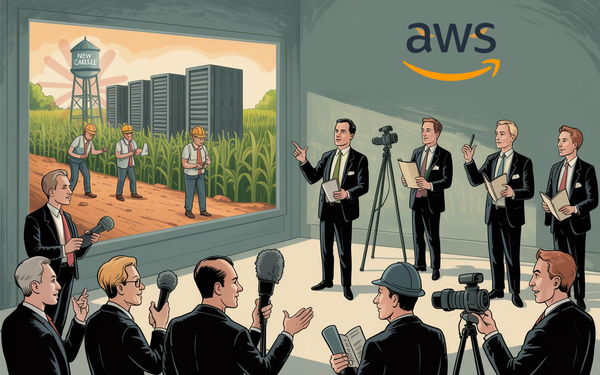

The AI revolution isn't just changing how we build—it's rewriting the very economics of innovation. We're witnessing the birth of a new entrepreneurial era where capital follows brilliance, not the other way around.

Rewriting the Rules of Innovation and Investment
A seismic economic realignment is underway: what once required fifty engineers, twenty million dollars, and three years can now be accomplished by five people, two million dollars, and six months. This isn't hyperbole—it's the mathematics of disruption unleashed by AI native businesses across every sector of the economy. While Silicon Valley debates AGI timelines, a more immediate revolution is quietly unfolding: the fundamental relationship between capital and value creation is being permanently inverted. The rules that have governed entrepreneurship for decades are breaking down, creating both unprecedented opportunities and existential threats for investors and founders alike. This transformation demands not just adaptation but a complete reimagining of how we fund, build, and scale the companies that will define our economic future.
The Mathematics of Disruption and How AI Changes Everything

Consider the implications across sectors:
In Enterprise Software: Traditional SaaS businesses required 150-200 employees to reach $10M ARR. AI-native companies are achieving the same revenue milestones with teams of 5-10 people. This doesn't just change hiring practices—it transforms the entire financial structure of the business, from capital requirements to valuation methodologies.
In Healthcare: Diagnostic technologies that once required $50M+ and 7+ years to reach market can now be developed by small teams leveraging AI for simulation, validation, and regulatory compliance—compressing both capital requirements and timelines by orders of magnitude.
In Manufacturing: Advanced materials and production technologies historically required enormous corporate R&D budgets. Today, AI-driven simulation and small-batch production capabilities enable nimble teams to innovate at a fraction of the cost and time, fundamentally challenging the innovation advantage of scale.
In Creator-Driven Industries: The explosion of individual creators leveraging AI tools to produce content indistinguishable from that of large studios or publishers represents perhaps the most visible example of this transformation—one individual with the right tools can now match the output of what previously required dozens.
The common thread across these examples isn't just efficiency—it's a fundamental inversion of the relationship between capital and value creation. For decades, we operated under the assumption that significant value creation required significant capital. That equation is now breaking down across industries, creating both extraordinary opportunities and existential challenges.
How Outdated Funding Models Are Stifling Innovation

This transformation exposes a critical misalignment in how we finance innovation. For investors, traditional models—with their expectations of massive dilution, founder subordination to investor interests, and binary outcomes—increasingly conflict with the realities of AI-native company building. For founders, particularly those with deep domain expertise in capital-intensive fields, existing funding structures actively prevent breakthrough technologies from reaching commercialization.
This misalignment creates a paradoxical reality: while questionable social media apps secure hundreds of millions in funding, revolutionary technologies capable of transforming entire industries languish in university labs or corporate research departments, unable to secure appropriate capital for commercialization.
The traditional approach has forced innovators into an impossible choice:
- The Bootstrapping Mirage: Self-fund development requiring massive upfront investment—effectively a non-option for all but the wealthiest founders or massive corporations.
- The Venture Distortion: Contort the development process to match software-like timelines and growth curves, inevitably forcing compromises that undermine the technology itself.
- The Corporate Surrender: License breakthrough innovations to large incumbents at a fraction of their potential value, sacrificing control and most of the upside.
- The Academic Abandonment: Leave transformative technologies stranded in research papers, never making the leap to commercial implementation.
The economic consequences of this systemic failure are staggering, particularly in capital-intensive domains like semiconductors, where innovation powers a $4 trillion electronics ecosystem yet remains concentrated in a handful of massive companies that prioritize incremental advances over architectural breakthroughs.
From Personal Passion to Systemic Solution Through a Semiconductor Case Study
To illustrate how this plays out in practice, let me share a concrete example from my own experience. My journey into this world began decades ago, in a way that might feel familiar to many who grew up during the PC revolution. I remember the excitement of receiving my Pentium II 350MHz computer and meticulously assembling it. But what really captivated me was taking it apart again.
My brother turned me into his “child labor” before I knew about labor laws and became an unwilling apprentice, and through this hands-on tinkering on muscle cars and hot rods, I developed a deep understanding of hardware modification that has stayed with me throughout my career. What started as adolescent experimentation evolved into professional passion and started hot-rodding computers.
Regular pilgrimages to specialty computer parts stores led me to modify my system—adding components, swapping parts, essentially "hot-rodding" my computer into something beyond its original specifications. Then I custom painted it and made it look like a hot rod with a Hugger Orange coat of awesome, even had racing stripes!
Today, I'm essentially doing the same thing, except the computers I'm working with now are the size of a fingernail, packed with billions of microscopic components that make them exponentially more powerful than that Pentium II 350MHz system I first disassembled.
This intimate understanding of semiconductor evolution—from personal hobby to professional pursuit—gave me a front-row seat to the innovation bottlenecks plaguing the industry. It became painfully clear that brilliant engineers could design revolutionary architectures on paper, but the path from concept to commercialization was blocked not by technical challenges, but by fundamentally misaligned funding structures.
When a team of six engineers—all veterans of a major semiconductor company's recent layoffs—approached me with a breakthrough chip architecture for AI acceleration, we witnessed this funding conundrum firsthand. Their innovation promised a 9x improvement in performance-per-watt for edge AI applications—a transformative advance with applications spanning autonomous vehicles, smart infrastructure, and next-generation mobile devices.
The technical merit of their chip design was undeniable, but the funding landscape presented seemingly insurmountable challenges:
- Traditional VCs balked at the $8 million required to reach first silicon, demanding unrealistic timelines and dilution that would have stripped the founders of meaningful ownership before they could prove their technology's value.
- Strategic investors from established chip companies offered funding but demanded exclusive licensing rights that would have capped the technology's potential and the team's upside.
- Government grants could cover some R&D costs but moved too slowly and came with bureaucratic overhead that would have bogged down the nimble team.
This scenario perfectly illustrates the fundamental misalignment between traditional funding instruments and the realities of hardware development—a gap that has strangled innovation in capital-intensive domains for decades.
The SAFE Conundrum — When Financial Instruments Become Obsolete
The challenges facing hardware innovation reflect a broader problem emerging across startup financing. As AI enables smaller teams to build larger businesses with less capital, traditional financial instruments are revealing critical flaws.
This new reality of elite, efficient teams isn't just changing how companies operate—it's fundamentally undermining the financial instruments that have powered early-stage investing for the past decade. As Silicon Valley startup lawyer Chris Harvey observes, Simple Agreements for Future Equity (SAFE’s) may be facing an existential crisis in the age of AI-enabled efficiency.
The SAFE, pioneered by Y Combinator and now used in over 90% of pre-seed investments, was designed with a crucial assumption baked into its DNA: that startups would inevitably need additional equity financing, triggering conversion of the SAFE into actual ownership. But what happens when that assumption no longer holds? When the mathematics of company building has fundamentally changed?
Harvey highlights a sobering reality for early investors: legally, founders aren't obligated to convert SAFE’s unless there's a future equity round or an exit. In today's AI-accelerated environment—where companies raise one initial round, leverage AI to minimize costs, scale efficiently to meaningful revenue, and then self-fund through profitability—the triggering events for SAFE conversion may never materialize.
This isn't theoretical. The precedent is already established in case law. In the high-profile Toptal case, investor Denis Grosz found himself holding a convertible note that never converted because the company scaled profitably without further fundraising. Not only did Grosz fail to secure equity in what became a billion-dollar revenue business, but he was ultimately liable for over $15 million in damages when attempting to enforce what he believed were his rights.
This reveals a profound misalignment between founders and investors that threatens early-stage investing itself. Investors believing they're purchasing future equity may instead be providing what amounts to non-convertible, zero-interest loans. Simultaneously, founders may structure their businesses specifically to avoid conversion triggers—essentially using SAFE’s as ultra-cheap growth capital with no intention of providing the equity investors thought they were buying.
Y Combinator, which pioneered the SAFE and remains central to early-stage investing, faces particular pressure as this reality dawns on the market. If AI-native startups consistently demonstrate the ability to scale without further equity rounds, YC may be forced to revise its investment terms to ensure it receives actual ownership in the companies it funds.
What we're witnessing is the obsolescence of financial instruments that haven't kept pace with technological innovation—a problem particularly acute in capital-intensive domains like semiconductors, where funding misalignment has blocked innovation for decades.
Seed-Strapping — A New Funding Paradigm for the AI Era

The convergence of AI-accelerated development capabilities and the failures of traditional funding instruments demands a comprehensive rethinking of how we finance innovation. This is particularly true in domains like semiconductor development, where traditional models have consistently failed despite the enormous potential value.
A false binary has dominated entrepreneurial thinking for too long: bootstrap your way to freedom or surrender equity to venture capitalists for growth. This outdated paradigm fails to recognize how artificial intelligence is transforming company building fundamentals. What we're witnessing isn't a sudden revolution but an acceleration of evolutionary forces that have been reshaping startup economics for years.
The Fundamental Failures of Traditional Funding Models
To understand why new funding paradigms are necessary, we must first recognize how thoroughly traditional models have failed most participants:
The bootstrapping path, romanticized as the route to independence, is in reality a brutal war of attrition. When 80% of bootstrapped companies fail within 18 months due to cash constraints, we're not witnessing natural selection but a systemic failure to nurture promising innovations. Founders drain personal finances, max out credit cards, and operate in perpetual survival mode—conditions that stifle creativity and strategic thinking rather than enhancing them.
Meanwhile, the venture capital model has devolved into a wealth transfer mechanism that enriches a small ecosystem of insiders while failing most participants. When 75% of VC-backed startups never return capital to investors and founders typically end up with just 15% ownership if they reach Series C (which 99% never do), the system is clearly optimized for the wrong outcomes. The model forces companies toward hypergrowth trajectories regardless of whether that path makes sense for their business, resulting in artificial timelines and distorted priorities.
The hybrid "boot-scaling" approach—bootstrapping until traction, then taking significant funding—combines the worst aspects of both worlds. Founders endure years of resource-constrained struggle only to surrender massive equity (often 40-50%) in a single financing event. This approach also introduces cultural whiplash as companies transition from scrappy efficiency to aggressive, investor-driven growth—typically destroying the very qualities that made the business successful in the first place.
From Mass Layoffs to Elite Teams and the New Mathematics of Innovation
Against this backdrop of broken funding models, AI is enabling a fundamental shift in how companies form and operate. The recent wave of tech layoffs is catalyzing the next generation of hyper-efficient companies as thousands of highly skilled professionals find themselves suddenly freed from bloated corporate structures. The result is an innovation ecosystem defined by elite, small teams building with unprecedented capital efficiency.
The traditional venture approach rely on this dumb approach of "pray and spray" mathematics—invest in ten companies knowing nine will fail, hoping one delivers a 100x return to make the portfolio work. This model necessitated massive teams burning enormous amounts of capital in pursuit of hypergrowth at all costs.
But as one investor recently confided to me, "Those numbers don't work in the new mathematics we operate in." The AI-accelerated, post-layoff landscape is producing fundamentally different unit economics:
- Team efficiency: A layoff-hardened team of 3-5 elite performers can now build what previously required 30-50 people.
- Time compression: Development cycles that once took years now complete in months, dramatically reducing runway requirements.
- Success rate inversion: The combination of experienced talent, AI leverage, and capital discipline is inverting the success/failure ratio—more companies succeed than fail when building with this approach.
- Risk mitigation: The capital efficiency of these elite teams means investors can actually mitigate risk through portfolio diversification without requiring astronomical returns from each successful investment.
We've witnessed this transformation firsthand in our semiconductor venture studio. Veterans from recently downsized chip giants form small teams that leverage AI-powered design tools to accomplish what previously required massive engineering departments. The results are startling: development costs reduced by 70%, timelines compressed by 60%, and success probabilities increased dramatically.
Reimagining Investment Instruments for the AI Era
Returning to our semiconductor case study, we’ve approached the funding challenge with a fundamentally different perspective. Rather than forcing this innovation into ill-fitting traditional models, we recommended an entirely new approach tailored for hardware development:
- We can raise a $2.5 million initial round using our hybrid instruments, providing investors with both downside protection and significant upside if the technology succeeded.
- We can leverage our studio's shared infrastructure—including licensed EDA tools, testing equipment, and fabrication relationships—reducing the capital requirement by over 60%.
- We can employ AI-powered design verification that compressed the simulation and validation process from 18 months to just 5, dramatically accelerating time-to-silicon.
- We can establish clear technical and commercial milestones that triggered automatic conversion events for investors, ensuring alignment throughout the development process.
The results will prove that alternative funding models aren't just theoretically superior—they're practically essential for unlocking innovation in domains where traditional approaches have failed:
The team reached working silicon in 14 months (versus an industry average of 30+ months for comparable projects), validated their performance claims, and secured commercial partnerships that will generate revenue within 24 months of their founding—a timeline previously unheard of in semiconductor startups.
Most importantly, both the founding team and the investors are positioned to capture appropriate value from this breakthrough. The founders maintain controlling interest in their company while investors have clear paths to liquidity regardless of whether the company raises additional rounds, sells, or operates independently as a profitable entity.
This success stems from financial instruments specifically designed for the realities of AI-accelerated development. Forward-thinking venture studios with a focus on system on chip designs have pioneered several alternatives that align investor and founder interests in this new landscape:
- Revenue-Share Agreements with Algorithmic Growth Participation: Rather than equity that may never convert, our early investors receive priority access to revenue streams once products reach market—ensuring actual returns regardless of whether additional financing occurs. Critically, these agreements include algorithmic scaling mechanisms that increase the revenue share percentage as the business grows, simulating the upside potential of equity without requiring conversion events.
- Milestone-Based Conversion with Technical Triggers: Our investment instruments trigger conversion based on technological achievements and commercial milestones, not just financing events. When a chip passes simulation verification or reaches first silicon, conversion occurs automatically—protecting investors from the SAFE conversion trap while aligning incentives toward technical success rather than fundraising prowess.
- Mandatory Liquidity Provisions with Time Horizons: We build in requirements for providing investor liquidity after specific time periods or profitability thresholds. If a company remains private and profitable for five consecutive years, for example, a liquidity event is automatically triggered—ensuring capital doesn't remain permanently locked while allowing the business to operate independently.
- Hybrid Debt-Equity Structures with Domain-Specific Terms: For our semiconductor ventures, we employ instruments that provide guaranteed returns via debt components while preserving upside through equity rights. These structures explicitly acknowledge the unique capital requirements and development timelines of hardware innovation, with terms structured around tape-outs and production milestones rather than arbitrary calendar dates.
- Technical Milestone Insurance: Perhaps our most innovative mechanism, we've developed a system where investors receive insurance against technical failure. If specific technical milestones aren't achieved, investors receive additional compensation—creating a more balanced risk profile that acknowledges the inherent uncertainties in hardware development without forcing companies into premature scaling.
These innovations represent essential adaptations to the changing reality of company building in capital-intensive domains. Traditional investment instruments simply collapse under their inherent contradictions when confronted with smaller teams leveraging AI to build substantial businesses that still require significant upfront investment for hardware development.
Beyond Semiconductors and The Coming Investment Renaissance
The investment revolution sparked by AI extends far beyond semiconductors - it's reshaping the entire startup ecosystem. Just as the steam engine transformed manufacturing or the internet revolutionized commerce, AI is fundamentally altering the economics of innovation. This isn't a distant future - it's unfolding now, demanding immediate adaptation from investors and founders alike.
While my work has focused on semiconductor innovation through system on chip architecture and design, the principles underlying these funding innovations apply broadly across the AI-native landscape. The misalignment between traditional funding instruments and the new realities of company building isn't limited to hardware—it's becoming evident across the entire startup ecosystem.
The confluence of AI-driven efficiency, elite team formation, and the limitations of traditional funding instruments isn't a crisis—it's the catalyst for a renaissance in company financing and building. Just as the limited partnership structure revolutionized venture capital in the 1970s by aligning investors and fund managers, we're now witnessing the birth of entirely new funding paradigms that better align capital with modern innovation realities.
While semiconductor development utilizing system on chip design represents just one evolutionary branch in this emerging ecosystem. Different domains will develop different approaches, each tailored to the specific economics, timelines, and risk profiles of their industries. What works for SoC development won't necessarily work for AI-enabled services or biotech innovations.
The beautiful thing is we're not building the actual silicon from scratch—we're taking existing silicon and pairing it with other sensors and technologies, marrying them together in industry and category-defining applications. This approach allows us to reduce manufacturing time of SoC’s by months, and in some cases, years. By focusing on novel combinations and applications rather than starting from zero with new fabrication, we've found a way to unlock tremendous value while dramatically reducing both capital requirements and time-to-market.
But across this diversifying landscape, certain principles will prove universal:
- Explicit Alignment Through Innovative Instruments: The implicit assumptions that previously governed investment relationships must now be made explicit, with clear mechanisms for ensuring mutual benefit regardless of financing paths. This demands legal and financial innovation equal to the technological innovation it supports.
- Outcome Plurality Over Binary Thinking: Financial instruments must accommodate multiple successful outcomes beyond the traditional IPO or acquisition—including sustained profitability, revenue share, milestone achievements, and dividend distribution. The "unicorn or bust" mentality must give way to appreciation for diverse paths to value creation.
- Value-Based Returns Independent of Financing Events: Investors should capture value based on the actual success of the business, not just financing events or exits. This requires instruments that create liquidity and returns without forcing companies into unnecessary financing rounds or premature sales.
- Domain-Specific Structures That Respect Industry Realities: Investment structures should acknowledge the unique characteristics of different innovation categories rather than forcing all businesses into a one-size-fits-all model. The financing appropriate for social media apps is wildly inappropriate for semiconductor startups, and our instruments should reflect that reality.
- Capital Efficiency as Core Rather Than Consequence: Building lean, profitable businesses shouldn't be an accidental outcome but a deliberate strategy from inception. This requires founders and investors aligned around operational discipline rather than growth at all costs.
The true promise of the AI-native era isn't just more efficient companies, but a complete reimagining of how we finance and build ventures. The mathematics of company building has fundamentally changed, and our funding models must evolve with equal boldness. Those who cling to outdated systems risk being left behind in this new landscape of opportunity. The question for every investor and entrepreneur is clear: Will you be a pioneer in this new frontier, or a relic of the past?
Courtesy of your friendly neighborhood,
🌶️ Khayyam

Don't miss the weekly roundup of articles and videos from the week in the form of these Pearls of Wisdom. Click to listen in and learn about tomorrow, today.

Sign up now to read the post and get access to the full library of posts for subscribers only.

Khayyam Wakil is focused on deep tech, particularly in semiconductor innovation. With roots in innovation and hardware with a career spanning creative development, technical execution, and intellectual property. Now specializing in creating aligned capital models for breakthrough technologies.










Member discussion